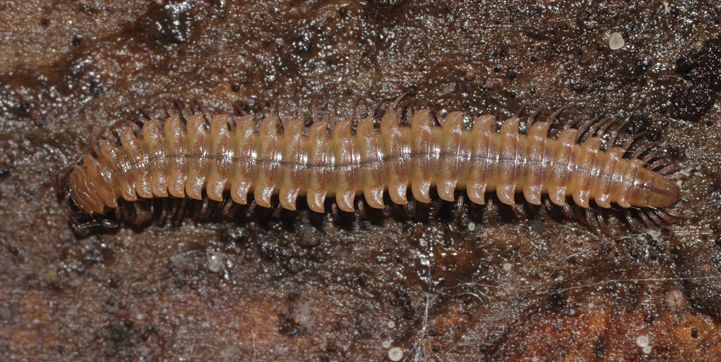|
Caseyidae
Caseyidae is a family of millipedes in the order Chordeumatida. Adult millipedes in this family have 30 segments (counting the collum as the first segment and the telson as the last). There are about 7 genera and at least 40 described species in Caseyidae. Genera * ''Caseya'' Cook & Collins, 1895 * ''Metopiona'' Gardner & Shelley, 1989 * ''Ochrogramma'' Gardner & Shelley, 1989 * ''Opiona'' Chamberlin, 1951 * ''Speoseya'' Causey, 1954 * ''Underwoodia (millipede), Underwoodia'' Cook & Collins, 1895 * ''Vasingtona'' Chamberlin, 1941 References Further reading * * * * Chordeumatida Millipede families {{myriapoda-stub ... [...More Info...] [...Related Items...] OR: [Wikipedia] [Google] [Baidu] |
Chordeumatida
Chordeumatida (from the Greek word for "sausage") is a large order of millipedes containing some 1200 species with a nearly worldwide distribution. Also known as "sausage millipedes," they possess around 30 body segments behind the head (including the telson) as adults and reach about in length. Description Chordeumatidans are relatively short-bodied, with only 26 to 32 body segments (including the telson) behind the head. They range in length from . A key feature is the presence of 6 large bristles (setae) on the dorsal surface of each body segment. The first segment ( collum) is relatively narrow, giving the appearance of a distinct "neck" in many species. The body tapers towards the rear, and the rearmost tip (telson) contains silk-producing organs (spinnerets). A dorsal groove runs down the length of the body, and some species possess paranota, lateral extensions of the exoskeleton. Paranota are also found in some other millipedes, notably Polydesmida, from which Chordeumat ... [...More Info...] [...Related Items...] OR: [Wikipedia] [Google] [Baidu] |
Opiona
''Opiona'' is a genus of millipedes in the family Caseyidae Caseyidae is a family of millipedes in the order Chordeumatida. Adult millipedes in this family have 30 segments (counting the collum as the first segment and the telson as the last). There are about 7 genera and at least 40 described species in C .... There are about 16 described species in ''Opiona''. Species These 16 species belong to the genus ''Opiona'': * '' Opiona berryessae'' Gardner & Shelley, 1989 * '' Opiona bifurcata'' Gardner & Shelley, 1989 * '' Opiona casualis'' Gardner & Shelley, 1989 * '' Opiona columbiana'' Chamberlin, 1951 * '' Opiona communis'' Gardner & Shelley, 1989 * '' Opiona confusa'' Gardner & Shelley, 1989 * '' Opiona distincta'' Gardner & Shelley, 1989 * '' Opiona exigua'' Gardner & Shelley, 1989 * '' Opiona facetia'' Gardner & Shelley, 1989 * '' Opiona fisheri'' Gardner & Shelley, 1989 * '' Opiona goedeni'' Gardner & Shelley, 1989 * '' Opiona gonopods'' * '' Opiona graeningi'' * '' Opiona h ... [...More Info...] [...Related Items...] OR: [Wikipedia] [Google] [Baidu] |
Underwoodia (millipede)
''Underwoodia'' is a genus of millipedes in the family Caseyidae. There are at least three described species in ''Underwoodia''. Species These three species belong to the genus ''Underwoodia'': * '' Underwoodia iuloides'' (Harger, 1872) * '' Underwoodia kurtschevae'' Golovatch, 1980 * '' Underwoodia tida'' Chamberlin, 1925 i c g Data sources: i = ITIS, c = Catalogue of Life, g = GBIF, b = Bugguide.net References Further reading * * Chordeumatida Articles created by Qbugbot Millipede genera {{myriapoda-stub ... [...More Info...] [...Related Items...] OR: [Wikipedia] [Google] [Baidu] |
Vasingtona
''Vasingtona'' is a genus of millipedes in the family Caseyidae Caseyidae is a family of millipedes in the order Chordeumatida. Adult millipedes in this family have 30 segments (counting the collum as the first segment and the telson as the last). There are about 7 genera and at least 40 described species in C .... There is at least one described species in ''Vasingtona'', ''V. irritans''. References Further reading * * Chordeumatida Millipedes of North America Articles created by Qbugbot {{myriapoda-stub ... [...More Info...] [...Related Items...] OR: [Wikipedia] [Google] [Baidu] |
Telson
The telson () is the posterior-most division of the body of an arthropod. Depending on the definition, the telson is either considered to be the final segment of the arthropod body, or an additional division that is not a true segment on account of not arising in the embryo from teloblast areas as other segments. It never carries any appendages, but a forked "tail" called the caudal furca may be present. The shape and composition of the telson differs between arthropod groups. Crustaceans In lobsters, shrimp and other decapods, the telson, along with the uropods, forms the tail fan. This is used as a paddle in the caridoid escape reaction ("lobstering"), whereby an alarmed animal rapidly flexes its tail, causing it to dart backwards. Krill can reach speeds of over 60 cm per second by this means. The trigger time to optical stimulus is, in spite of the low temperatures, only 55 milliseconds. In the Isopoda and Tanaidacea (superorder Peracarida), the last abdominal b ... [...More Info...] [...Related Items...] OR: [Wikipedia] [Google] [Baidu] |

